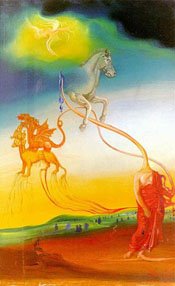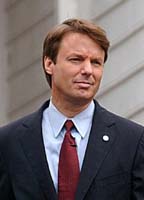Wormwood
by Bernie Quigley - to The Free Market News Network, 9/1/06 (Painting: The Second Coming of Christ by Salvador Dali)
 Behold, I come quickly. Revelation 22:7
Behold, I come quickly. Revelation 22:7
As we approached the end of the millennium there was a reawakening of an old idea historians had not so much abandoned as forgotten, as it was a good idea, but maybe too good. As in the writing of Oswald Spengler and Arnold Toynbee it gave such a comprehensive view of history ascending and yielding that it took all the air out of the room. We prefer Gibbon’s history of the fall of the Roman Empire. We understand falling. And sociologists can go back and tell us why we failed; to greedy, too driven, too stupid – a vision from which we can see ourselves repenting and repairing and starting all over again with renewed vigor and a clearer head.
But the saeculum theory being revived is based on ancient Roman historians view that no matter how smart, or how kind or how compassionate we are as a culture we will die anyway. Everybody dies. Not a unique idea, but one oddly displaced from human consciousness around the age of 60 when it becomes increasingly apparent that this is the destiny of all, individually or collectively. But as Spengler explained it in his typically oracular style, everybody dies but nobody dies, because like all things in nature, everything is born again in new forms.
Saeculum is Latin for a hundred year period and the saeculum theory of history has it that the big movements of history last 1,000 years and are divided into ten saecula; ten 100 year periods. It is kind of a neat picture, even with cosmic implications, as there are suggestions that the space between 1,000 year periods of advance, like that between the fall of the Roman Empire and the rise of the English/American Empire, is exactly 1,000 years as well. At the fall of Rome comes the awakening of Clovis in 400 A.D., carrying to the fall of Medieval Europe in the 14th century, for example, an age Robert Graves describes as the high water mark of the Earth Mother – Notre Dame, on the Ile de la Cite and Clovis’s birthplace - as she morphed into the Christian imagination. What moved out for 1,000 years turns inward for another 1,000 years. The warrior empire of Caesar left a conceptual casing across Europe empty in spirit, an empty castle, but one which would become the home of a sacred empire in its place. As Toynbee said, Yang becomes Yin; Particle becomes Wave.
The saeculum always consists of four generations, one alternating in opposition to the other, like a cosmic machine, until it completes itself in four generations. Historians William Strauss and Neil Howe, who have written about this recently, make the point that the saecula consistently begin to fail in the 60th to the 70th year, at the end of the third generation (in our period, that would be now). What is cool about this – except for the death part – is that the 1,000 year period as well reaches its height of power in the sixth saeculum and begins to fall apart then and into the seventh saeculum. The Roman Empire and its widespread army becomes a universal matrix but one without a substantial spiritual core to sustain it. Its soldiers live in a spiritual vacuum and are vulnerable to new ideas. The Mithrians would sweep trough in a mass movement and so would the Christ.
And we are there again, as in the hour of the Christ, approaching the Seventh Hour in our own Seventh Saeculum, a miasma of modest annoyance and depression when there are no outward places of tribal shamans and dream weavers and monkey gods and leopard kings with spears and mandalas which we can go to and easily conquer; no place left to go outside at all for adventure besides the Moon and Mars. It is a time when UFOs and visions of the Yellow Monk appear in the sky; a time when the flying horse Pegasus accompanies the Astrological Twins of Lemuria, Sanat and Sanada, on a new Journey of Creation and the faces of John the Baptist and Jesus are seen in the swirling vortex of twin hurricanes, Kristi and John, swirling across the South Pacific. A time, says Revelation, under the star called Wormwood.
What distinguishes our rise to English/American empire compared to the Romans is perhaps rapid turnaround. Strauss and Howe point out that the saeculum in our history is no longer 100 years as it was in Roman time. It is shorter. It is shrinking. Our post-war historical periods now last only eighty years. Here at the fourth generational turning, we can look back in hindsight and see how fast Our Mother succumbed 100 years ago.
At the top of the energy, Personality Cult dominates and carries the day. The Queen is no longer she who identifies and personifies the strengths and virtues of our tribe; she who holds us together; she who makes us unique and beautiful in the world. Instead, she has become Gargantua. She is the Goddess Incarnate, the Empress of India, Queen of the Whole World. Robert K. Massie’s Dreadnought well monitors the transition. In June, 1897, Queen Victoria was 78, had reigned over Great Britain and its empire for sixty years and a Diamond Jubilee had been proclaimed. Victoria’s navy present at the ceremony “appeared to be an enormous city. One hundred and sixty-five warships of the British Navy . . . . Five lines of black-hulled ships, thirty miles of warships, they carried forty thousand men and three thousand navel guns. It was the most powerful fleet assembled in the history of the world.”
But her time in the world was soon up. When Victoria’s grandson, Kaiser William II sought world power, she would break her European alliances and instead seek support under the cloak of American power, and she would remain to this day, our protectorate.
The days of the high Victorians were marked by hubris and fantasies of Invulnerability; there will always be an England; the Sun never sets on the British Empire. It would bring a hard fall. Graves’ book, Goodbye to All That, would reveal in England an empire, like Rome’s, spiritually empty, sick and obsessed at its core. 50 years later, J.R.R. Tolkien would comment that all the boys he knew at age 12 were dead by the time he was 20. But the glory that was Victoria was unmatched in the annals of the English-speaking world. It was a muddled grandeur, says Victoria’s noble subject and loyal chronicler, James Morris, and at the time of the Diamond Jubilee, the imperial spirit was already cracked by the Boer War. Shortly thereafter it would be destroyed.
I’d begun to think we had reached our own Diamond Jubilee in America shortly after the first Gulf War, with President Bill Clinton bringing us our own high Victorian moment. Clinton had come to be seen, like Victoria, as a world figure, and he began to see himself that way. Clearly, he preferred to spent time with world leaders like Nelson Mandela and could barely tolerate ordinary political doings with regular folk like Trent Lott. Likewise, in retirement, he sees himself as a kind of Cosmic Figure, a cross between Elvis and Gandhi, a global healer, and like Elvis as he descended into delusion, more man-god than man. Last summer he actually wanted to start his own United Nations. To his surprise, few responded.
Perhaps in the Clinton Era we were at a World Moment as we were in Victoria’s Diamond Jubilee. Even world financiers like George Soros saw all the people in the world as Americans by degree and has suggested that all be given some say in American government. We grandly expressed Infallibility and Immortality as did the high Victorians. The stock markets, we were told, would rise to 35,000 and wiser voices which might prevail in journals like this one were silenced. Of well-known and popular writers only John Kenneth Galbriath, still at this desk at Harvard in his 90s, challenged this vision of globalization as one of colossal, pending failure. Indeed, rising NASDAC stocks in Silicon Valley, which were clearly and obviously unfunded, continued to skyrocket. It was only our vision of Invincibility which motivated these empty investments. It would be a hard fall and on 9/11 we would turn a page.
When historians return and look at our turn around, I think they will see it beginning at the moment we became a debtor nation. But decline will be graphed by character. Thomas E. Ricks’ new book, Fiasco: The American Military Adventure in Iraq, will provide a milestone. Ricks’ book clearly outlines the debacle in Iraq lie by lie, deceit by deceit. But in the end, the question has to be asked of the whole society, how did people of the lowest abilities reach the highest offices in the land? Ricks identified George W. Bush, the CIA’s George Tenet, Secretary of Defense Donald Rumsfeld and Tommy Franks, Commander-in-Chief of the United States Central Command, as key figures in the colossal failure of Iraq and points to Paul Wolfowitz and Richard Perle as the engineers of this misadventure, waiting in the wings long years for an innocent waif like Bush to come to the Presidency.
In my reading, Franks, who has been given the nation’s highest award and has been Knighted by Queen Elizabeth, establishes the paradigm in complete. Ricks describes Franks as virtually unable to understand strategy. In the military, strategy is the overall view; what are your objectives and what will the world look like in war’s aftermath? What is the world you are creating with warfare? But Franks was virtually unable to see that the “liberation of Baghdad” was not the same as winning the war. Again and again when he attempts to describe strategy, he describes tactics. We’re going to go in and whoop ‘em and this is how we are going to hit them. As Ricks points out, this is the job of a staff sergeant and Tommy Franks was virtually a staff sergeant with four stars.
Ricks describes many brilliant, brave and honorable officers, men and women of all ranks, who are as good as any we have seen at any time in our history. Perhaps the most important question we should ask today is how did these excellent men and women become systematically sidelined throughout their careers while incompetents like Franks were promoted to the top of the U.S. Army?
And it is a question which should be asked not only of the Army, but of the State Department, the CIA, and Department of Defense and in particular, the Presidency. And as National Dept grows at $1.71 billion a day to $8,506,731,239,927 today, it is a question we need to ask now of all aspects of government.
The vision of One World in the Clinton era, like that of the Woodrow Wilson era, was fleeting. Both parties now are nostalgico parties as in Franco’s Spain, the one yearning back to Our Victoria, Bill Clinton, the other yearning back to World War II. Neither has the élan of Jack Kennedy, the great rising spirit of the Democrats, nor the abilities of Dwight Eisenhower, perhaps the greatest military strategist of all time.
It would be good if like England, we had a Big Brother or Sister, 100 times our size, to come in and save us at the moment of crisis. But Russia is not our friend. India resents us. I hear from China investors that China truly hates us. And so does Islam now with its one billion people. That doesn’t leave many else.
Historians of Victoria’s vast empire easily illustrate it with graphic images of a map of the Empire at the rise of Victoria’s realm growing to cover what looks like most of the world. Then at the end it is only a few tiny and troubled spots on a map, without even little Ireland.
It brings to mind Eisenhower’s sphere of influence starting at Japan and crossing the world unstopped to half way through German. In contrast with Rumsfeld’s Coalition of the Willing; Slovenia, Armenia, Mongolia, Denmark, Kazakhstan, Macedonia, Romania and a few others. And of course, England.
In Revelation, the voice of the Seventh Angel says, “It is done.” Let us hope this Angel does not speak to us.
 Congratulations on your retirement from a life of good work & work that needed to be done. Perhaps it is only a coincidence that you gave your parting speech in the same week that the Senate allowed the President to repeal Habeas Corpus. Over the years I have admired your character and courage and solicited your support. One such time was at the beginning of the war on
Congratulations on your retirement from a life of good work & work that needed to be done. Perhaps it is only a coincidence that you gave your parting speech in the same week that the Senate allowed the President to repeal Habeas Corpus. Over the years I have admired your character and courage and solicited your support. One such time was at the beginning of the war on 











